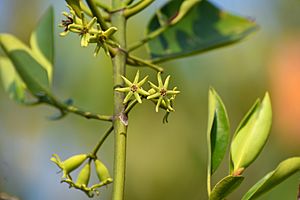Bruguiera cylindrica facts for kids
Bruguiera cylindrica is a special type of tree called a mangrove. It belongs to the Rhizophoraceae family, which is known for its mangrove trees. You can find this tree growing in the wet, muddy areas called mangrove swamps across tropical parts of Asia.
Quick facts for kids Bruguiera cylindrica |
|
|---|---|
 |
|
| Conservation status | |
| Scientific classification | |
| Genus: |
Bruguiera
|
| Species: |
cylindrica
|
| Synonyms | |
|
|

Contents
What Does Bruguiera cylindrica Look Like?
Bruguiera cylindrica is usually a small tree. It can grow up to 20 meters (about 65 feet) tall. Sometimes, it looks more like a large bush.
Tree Trunk and Roots
Its bark is smooth and grey. It has special bumpy spots called lenticels. These spots help the tree breathe. The bottom of the trunk has strong roots that spread out. These roots help the tree stand firm in the soft, wet soil.
This mangrove also has unique roots that stick out of the mud. They look like bent knees! These are called pneumatophores. They also have lenticels, which let air into the roots. This is important because the soil in mangrove swamps is often underwater and has little air.
Leaves and Flowers
The leaves of Bruguiera cylindrica are shiny green. They grow in pairs, one across from the other. Each leaf is oval-shaped with a pointed tip.
The flowers grow in small groups of 2 to 5. They are found where the leaves meet the stem. Each flower has 8 long green parts called sepals. It also has 8 smaller, greenish-white petals. These petals have tiny bristles on their tips. Insects help pollinate these flowers. When an insect touches the flower, a puff of pollen is released.
Special Seeds: Propagules
Unlike most plants, the seed of Bruguiera cylindrica starts growing while it's still attached to the tree. This young plant is called a propagule. It looks like a slightly curved, slender cucumber. It can grow up to 15 centimeters (about 6 inches) long.
When the propagule is ready, it drops off the tree. At first, it floats flat on the water. The bottom part of the propagule soaks up water and gets heavier. After a few weeks, it floats straight up and down. This means it's ready to root into the mud and grow into a new tree!
How to Tell it Apart
It can be tricky to tell Bruguiera cylindrica apart from another mangrove called Bruguiera gymnorhiza. But Bruguiera gymnorhiza has bigger, red flowers. Its propagules are also straight, not curved.
Where Does Bruguiera cylindrica Grow?
Bruguiera cylindrica is found in many tropical Asian countries. This includes India, Sri Lanka, Malaysia, the Philippines, Thailand, Vietnam, Indonesia, and New Guinea. It even grows in Queensland, Australia. It is one of the most common mangroves you can see in Singapore.
This tree likes to grow on new mud and silt. It often grows behind other mangroves, like Avicennia trees. These other mangroves can handle more salt. Bruguiera cylindrica does not grow easily from broken branches.
Life in the Mangrove Swamp
Mangrove swamps are amazing places full of life! They have a huge variety of plants and animals. This is called biodiversity.
Animals and Fungi
Many sea creatures live among the roots of mangroves. These include sponges, sea squirts (called ascidians), molluscs like snails and clams, shrimps, and crabs. You can also find many different kinds of fish and birds.
Lots of insects visit mangroves too. Some insects eat the leaves. Others are parasites, meaning they live on other creatures. And some are predators, meaning they hunt other insects. Each type of mangrove tree often has its own special insects that feed on it. Many types of marine fungi also grow in mangrove swamps, including on Bruguiera cylindrica.
What is Bruguiera cylindrica Used For?
Bruguiera cylindrica wood is very useful. It is strong, dense, and has a reddish color.
Timber and Fuel
People use this wood for building things. In the Maldive Islands, it's used to make parts of canoes, especially the bottom part called the keel. The wood also burns well as firewood. It can even be turned into charcoal.
Other Uses
The crushed bark of this tree has a strange smell that fish don't like. Because of this, the wood is not used for fish traps. However, special liquids are taken from the knee-shaped roots (pneumatophores). These liquids are used to make perfume!
Parts of the tree are also eaten. In Thailand, the tips of the roots are a tasty food. The bark can be used as a spice. The young shoots are boiled and eaten as a vegetable. In the Maldives, the propagules (the cucumber-like young plants) are boiled and eaten as a vegetable.
Traditional Medicine
In traditional medicine, the skin of the fruit is used to help stop bleeding. The leaves are also used to help lower blood pressure.


